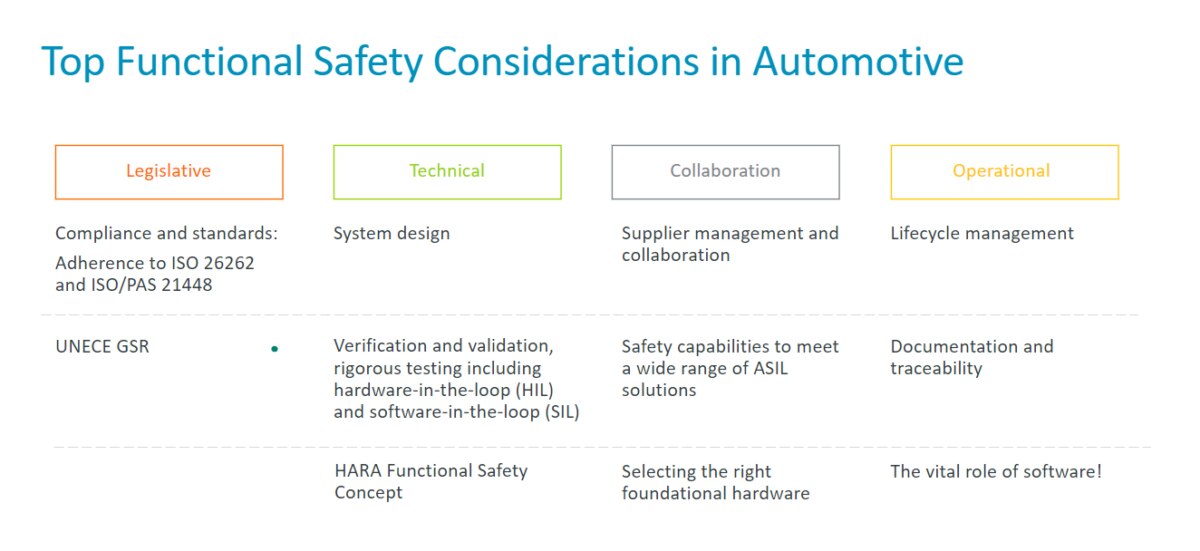Driving the Future: Essential Functional Safety Considerations for Automotive Leaders

The automotive industry is rapidly evolving, driven by changing consumer demands for safer, smarter, and more connected vehicles. This, coupled with the rise of autonomous driving, electric vehicles, and advanced driver-assistance systems (ADAS), the overall complexity of automotive systems has increased significantly – and this brings new safety challenges that must be addressed to protect end-users while ensuring optimal driving experience.
What is functional safety?
Functional Safety is essential for ensuring systems operate correctly in response to inputs, particularly in automotive and industrial IoT markets. It plays a vital role in reducing residual risk through rigorous processes and standards. This ensures systems perform safely under all conditions, including preventing unacceptable risks from hazards caused by malfunctioning electrical and electronic (E/E) systems in vehicles.
Functional safety ensures that vehicles respond correctly to their inputs, thereby preventing malfunctions and safeguarding passengers. A vital part of this is building products for the automotive industry that are functionally safe by following the top considerations below.
Top considerations for automotive functional safety
Building the right safety design
Building the right safety design for the intended product involves meeting top-level safety requirements and goals to reduce potential hazards. Key design considerations include implementing redundancy, diversity, execution of STLs, and safe state design to ensure system reliability.
Arm’s latest Automotive Enhanced (AE) product portfolio offers customizable and scalable solutions to meet specific safety requirements.
Compliance with standards
The intended product based on the target solution must comply with relevant regulations and safety standards. For example, an ADAS solution should adhere to UNECE GSR and standards like ISO 26262, ISO 21448 (SOTIF), and ISO 21434, ensuring the correlation between safety and security.
From an Arm AE product perspective, meeting ISO 26262 standards is crucial for vehicle lifecycle safety underpins partner solutions. Arm’s Safety Ready solutions are designed with a “safety first” approach, incorporating advanced safety mechanisms and comprehensive packages to help partners achieve ISO 26262 compliance.

Risk Management
Building functionally safe systems requires a thorough risk analysis at a vehicle level to perform Hazard Analysis and Risk Assessment (HARA) and Failure Mode and Effects Analysis (FMEA). These systemic analysis tools help to build robust systems and components, some of which are key to Arm’s AE processors, including those in the Cortex-A and Cortex-R range.
Verification and validation
Rigorous testing, such as hardware-in-the-loop (HIL) and software-in-the-loop (SIL) simulations, is crucial. Arm and our partners facilitate this by creating virtual platforms that offer early access to software development, reducing development cycles and ensuring scalable redeployment across a wide range of vehicles.
Supplier management
Effective communication between OEMs and Tier 1 suppliers is crucial. The Arm ecosystem, which involves collaborations with automotive industry leaders, ensures seamless access to tools, resources, and expertise for effective supplier management.
Lifecycle Management
Promoting a culture of safety and implementing continuous improvement processes are essential for maintaining high safety standards. Arm’s Flexible Access program allows OEMs and Tier 1 suppliers to evaluate different IP technologies cost-effectively, making them more informed consumers of SoCs from their suppliers.
Documentation and traceability
Maintaining detailed documentation and ensuring traceability of safety requirements is crucial. Through our Partner Program, Arm offers comprehensive support to help navigate functional safety compliance through its industry-leading safety package solution to support the Arm AE product portfolio.
Choosing the right technologies for the right use cases
Functional safety requirements vary by use case. Autonomous driving systems demand ASIL D integrity, while less critical systems may require ASIL B. The Arm Reference Design-1 AE (RD-1 AE) targets the automotive segment, delivering a high-performance Arm Neoverse V3AE CPU with an Arm Cortex-R82AE-based Safety Island for additional safety monitoring. The Cortex-R82AE processor meets ASIL D requirements for high reliability.
Selecting the appropriate technology is essential. Arm offers compute solutions tailored to different safety needs. Cortex-R processors are designed for safety islands and real-time automotive applications, while Cortex-A processors handle complex computing tasks, such as autonomous driving features utilizing split, lock, and hybrid configurations.
Learn more about Arm Hybrid, Split, and Lock Modes.
The vital role of software
Software is pivotal in optimizing functional safety across the automotive industry and ensuring optimal driver experience. Arm’s Software Test Libraries (STLs) are designed to enhance the safety of automotive applications by providing comprehensive testing and validation tools. These libraries help developers ensure that their software meets the stringent safety standards required in the automotive industry.
Arm’s functional safety run-time system (FuSa RTS) is a set of certified software components to reduce time and effort to achieve final safety certification in a wide range of embedded applications.
The system includes a robust real-time system (RTOS), an independent processor abstraction layer, and a verified C library highly optimized for Cortex-M processors by Arm’s architecture experts. It is optimized for native use with the Functional Safety Compiler and our embedded toolchain Arm Keil MDK.
Furthermore, Arm relies on its vast partner ecosystem, including those that are members of SOAFEE, to build functional safety and automotive safety software applications.
The future of automotive safety is being built on Arm
As the automotive industry continues to innovate, the importance of functional safety will only grow. Arm’s new AE processors, built on the Armv9 architecture, bring server-class performance and advanced safety features to automotive applications, ensuring that future vehicles can handle the increasing demands of automation and connectivity. Arm’s AE processors are flexible and can improve the efficiency of safety-critical computations by up to 30%, providing a robust platform for future automotive innovations.
Arm has been trusted as a leader in safety-enabled compute by the automotive industry for more than 30 years. The Arm AE product portfolio provides a rich set of options to our partners, whether they are targeting ASIL B usage or full ASIL D capabilities for different processing elements in their solutions. Moreover, with our industry-leading ecosystem, we are enabling full-stack software solutions that run on the latest Arm AE products across a range of automotive applications, from zonal and in-vehicle infotainment (IVI) to ADAS and autonomous driving systems (ADS).
Working with Arm’s complementary software, which includes STLs and SystemReady, enables a broad range of functional safety features and optimizes the performance, power, and area (PPA) for the desired safety capability of the automotive computing system.
This powerful combination of innovative hardware and software means that automotive safety, now and in the future, is being built on Arm.
Arm’s Safety Technologies
Learn more about Arm’s Functional Safety technolgies.
Any re-use permitted for informational and non-commercial or personal use only.












